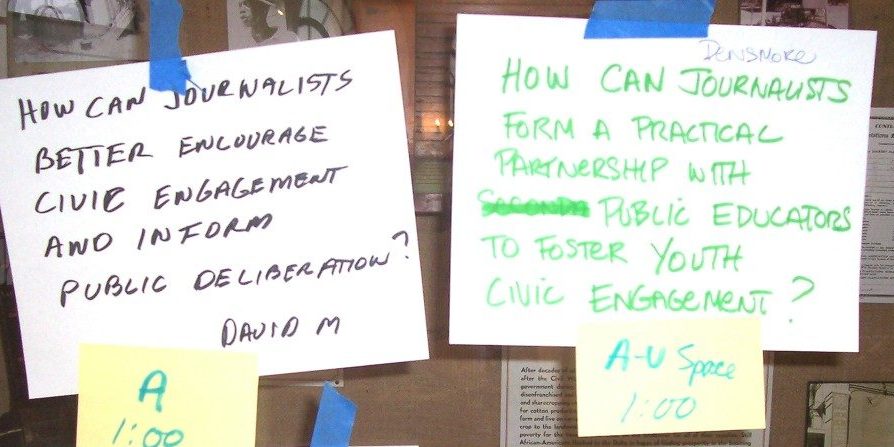“Memphis has always been a place where cultures come together to have a wreck; black and white, rural and urban, poor and rich. The music in Memphis is more than a soundtrack to these confrontations. It is the document of it.”
It Came from Memphis, a book by Robert Gordon, Peter Guralnick about the Memphis music scene
On Jan. 11 and 12, 2007 some 40 journalists, educators, and media reformers from print, broadcast and new media, both mainstream and independent, came together to consider the intersection of journalism and media reform.
Commitment to the essential role of journalism for a strong democracy, increased optimism, and a sense of renewal and fellowship emerged as the gathering’s common ground.
The session was co-convened by Journalism that Matters and the Media Giraffe Project, with hosts Chris Peck, Geneva Overholser, and Bill Densmore — and supported by facilitators Peggy Holman and Stephen Silha. The participant mix roughly included: 40% print, 20% broadcast, 20% new media, 15% educators, 10% media reformers, 10% other, with 75% hailing from the mainstream.
Following a round of introductions, we were hosted to a home-cooked Southern dinner by Chris Peck and his wife, Kate Duignan – no small feat to feed this crowd! Once well wined and dined, we used a “Samoan Circle” – a conversation among the whole witnessed by all as people flowed in and out of four chairs in the center of the packed living room. Heated at times, this opening exploration of what is emerging in the new media landscape set the stage for opening the space the next day to explore: “Given we are all in this together, what’s possible now
Topics of Friday’s Open Space included:
- How do we develop a new breed of media owners?
- Building Bridges between MSM and Digital New Media
- What role should journalists play in media literacy and citizen engagement?
- Civic Engagement and Public Deliberation
- How can journalists form a practical partnership with public educators to foster youth civic engagement?
- How does journalism treat regional issues?
Other topics posted and combined with those above:
- How can we support/foster good economic models to support news/journalism in the public interest?
- What does it mean for “news” if the web is a tool for action?
- Citizen or working journalist – what’s the difference and why should we care?
- Does USA Today suck? Why is it in every hotel in America and what does that say about public attitudes?
- How can we better understand what people want—not just what we think they need?
End-of-day themes
At the end of the day, people gathered in groups of four to five to coach each other in pursuing their own next steps. Among the themes that emerged from the gathering were:
- An interest in the question: What does journalism look like when that’s all that’s left?
- An exploration of a new role for journalists – as conveners of conversations
- Creating an open source template to turn a news organization into a public trust in any community
- The realization that the newsroom is leaving the building
- Like the music from Memphis, mainstream and alternative journalism are on intersecting paths – with the same creative potential
- Several very personal projects – ranging from a book and blog on Post Traumatic Stress Disorder and its various permutations, to a website on an experimental filmmaker/poet, to a series of roundtables on media credibility – were described and enumerated.
Chris Peck summed up the day describing three paths and two bridges:
“One path is the reform of legacy media from within. A second path is a new economic model in which journalism is a public trust. The third route is the stand-alone journalist – one who is honorable, seeks the truth, and does it on her or his own – for example, Glenn Reynolds, at www.instaPundit.com. In addition, there has to be a bridge for the legacy media people to understand the mindset and tools of the digital world, overcoming fear, contempt, lack of understanding. The bridge goes the other way as well – if you get into the journalistic world you have to be credible, accountable, understandable.”
Some reflections on the experience by David Zeeck, executive editor of the Tacoma News Tribute and president of the American Society of Newspaper Editors, are at:
http://www.thenewstribune.com/news/columnists/zeeck/story/6323222p-5512332c.html
Next gathering Aug. 7-8, Washington, D.C.
The next gathering, focused on the question “What does journalism look like when that’s all that’s left? and its implications to curriculum for media literacy, current and aspiring journalists is in the planning. Planned to be held as an opener to the Association for Education in Journalism and Mass Communication conference in Washington, D.C., the dates are August 7 and 8.
